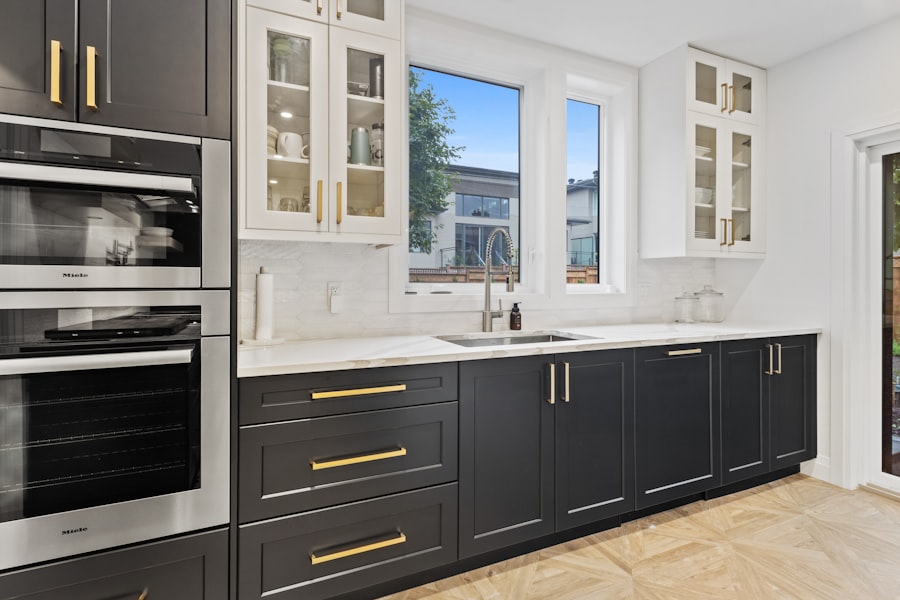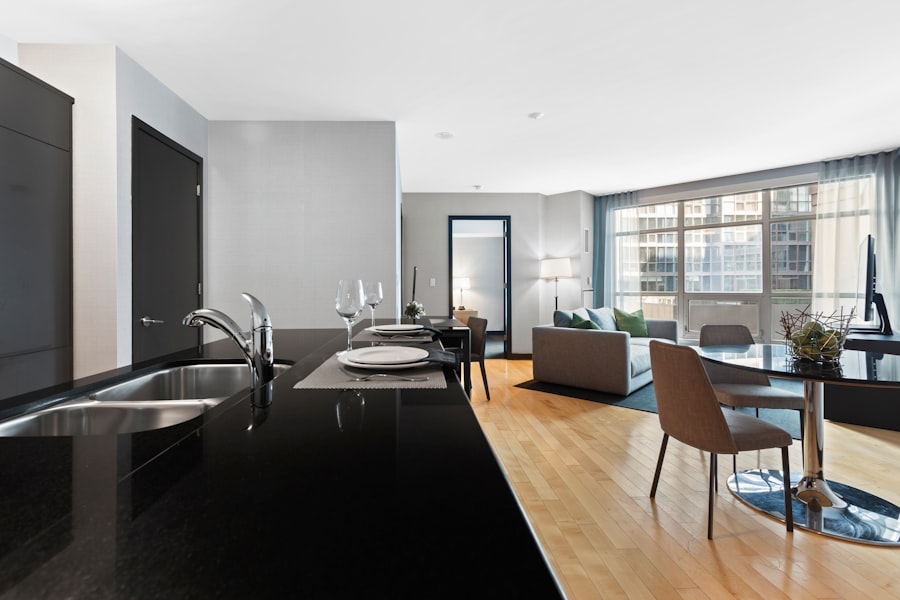Built-in cabinets have become a staple in modern interior design, seamlessly blending functionality with aesthetic appeal. These fixtures are not merely storage solutions; they are integral components of a room’s architecture, enhancing both the utility and visual harmony of a space. Unlike freestanding furniture, built-in cabinets are designed to fit snugly into specific areas, often utilizing every inch of available space.
This tailored approach allows homeowners to maximize their storage capabilities while maintaining a clean and cohesive look throughout their living areas. The history of built-in cabinets can be traced back to the early 20th century when they began to gain popularity in American homes. Initially, they were primarily functional, serving as a means to store household items efficiently.
However, as design trends evolved, so did the purpose of built-in cabinets. Today, they are not only practical but also serve as focal points in a room, showcasing personal style and enhancing the overall decor. From traditional woodwork to sleek modern designs, built-in cabinets can be found in various styles that cater to diverse tastes and preferences.
Key Takeaways
- Built-in cabinets offer tailored storage solutions that enhance room functionality and organization.
- Customization options allow for personalized designs that fit various styles and spaces.
- They can be integrated into multiple rooms, including kitchens, living rooms, and bedrooms, to maximize utility.
- Choosing the right materials and finishes is essential for durability and aesthetic appeal.
- Budget-friendly ideas and proper maintenance help extend the life and look of built-in cabinets.
Functionality and Storage Solutions
One of the primary advantages of built-in cabinets is their unparalleled functionality. These cabinets can be designed to serve multiple purposes, accommodating everything from books and decorative items to kitchenware and electronics. In living rooms, built-in cabinets can house media equipment, providing a designated space for televisions, sound systems, and gaming consoles while keeping wires and clutter out of sight.
This organized approach not only enhances the room’s appearance but also creates a more enjoyable viewing experience. In kitchens, built-in cabinets can be tailored to meet specific storage needs, such as incorporating pull-out shelves for pots and pans or deep drawers for larger items. The ability to customize these cabinets means that homeowners can create a layout that works best for their cooking habits and lifestyle.
Additionally, built-in cabinets can include features like lazy Susans or pull-out spice racks, making it easier to access frequently used items without rummaging through cluttered spaces. This level of organization is particularly beneficial in smaller kitchens where maximizing storage is essential.
Customization and Design Options

The customization options available for built-in cabinets are virtually limitless, allowing homeowners to create pieces that reflect their unique style and meet their specific needs. From choosing the layout and dimensions to selecting hardware and finishes, every aspect can be tailored to fit the individual’s vision. For instance, a homeowner may opt for open shelving in certain areas to display decorative items while incorporating closed cabinetry for more utilitarian storage.
This blend of open and closed storage not only adds visual interest but also provides flexibility in how items are displayed and stored. Design options also extend to the materials used in constructing built-in cabinets. Homeowners can choose from a variety of woods, laminates, and even metals to achieve the desired look.
For a rustic feel, reclaimed wood can be used, while sleek finishes like high-gloss lacquer can lend a contemporary touch. Additionally, the choice of color plays a significant role in the overall design; lighter shades can make a space feel more open and airy, while darker hues can add depth and sophistication. The ability to customize every detail ensures that built-in cabinets can harmonize with existing decor or serve as standout features within a room.
Incorporating Built-In Cabinets into Different Rooms
| Room | Common Cabinet Types | Average Installation Time (hours) | Typical Storage Capacity (cubic feet) | Popular Materials | Primary Benefits |
|---|---|---|---|---|---|
| Kitchen | Base Cabinets, Wall Cabinets, Pantry Cabinets | 20-30 | 15-25 | Wood, MDF, Laminate | Maximizes storage, improves organization, enhances aesthetics |
| Living Room | Entertainment Centers, Bookcases, Display Cabinets | 15-25 | 10-20 | Wood, Glass, Metal | Creates focal points, hides clutter, adds style |
| Bathroom | Vanity Cabinets, Medicine Cabinets, Linen Storage | 10-15 | 5-10 | Moisture-resistant Wood, MDF, Laminate | Optimizes small spaces, protects items from moisture |
| Bedroom | Closet Systems, Dressers, Nightstands | 15-20 | 12-18 | Wood, MDF, Veneer | Improves organization, maximizes storage, custom fit |
| Home Office | Desks with Cabinets, Filing Cabinets, Shelving Units | 12-18 | 8-15 | Wood, Metal, Laminate | Enhances productivity, organizes documents, saves space |
Built-in cabinets can be effectively integrated into virtually any room in the home, each serving distinct purposes that enhance functionality and style. In the living room, for example, built-ins can frame a fireplace or serve as an entertainment center, providing both storage and a visually appealing backdrop for family gatherings. By incorporating lighting within these cabinets, homeowners can highlight decorative pieces or create an inviting ambiance during evening hours.
In bedrooms, built-in cabinets can take the form of wardrobes or bedside tables, offering efficient storage solutions without taking up valuable floor space. A built-in headboard with integrated shelving can provide a stylish focal point while also serving practical needs for books and personal items. In home offices, built-in cabinetry can be designed to accommodate files, office supplies, and technology, creating an organized workspace that promotes productivity.
The versatility of built-in cabinets allows them to adapt to the specific requirements of each room while maintaining a cohesive design throughout the home.
Materials and Finishes for Built-In Cabinets
The choice of materials and finishes for built-in cabinets significantly impacts their durability, appearance, and overall functionality. Solid wood remains a popular choice due to its timeless appeal and strength; species such as oak, maple, and cherry offer varying grains and colors that can enhance any design scheme. However, engineered materials like plywood or MDF (medium-density fiberboard) are also widely used due to their cost-effectiveness and versatility.
These materials can be easily painted or veneered to achieve the desired look without compromising on quality. Finishes play an equally important role in the final appearance of built-in cabinets. Stains can enhance the natural beauty of wood while providing protection against wear and tear.
Paint offers an opportunity for bold expression; homeowners may choose vibrant colors for a playful touch or muted tones for a more sophisticated look. Additionally, finishes such as matte or satin can affect how light interacts with the surface, influencing the overall ambiance of the room. The careful selection of materials and finishes ensures that built-in cabinets not only serve their functional purpose but also contribute significantly to the aesthetic value of the home.
Maximizing Space with Built-In Cabinets

One of the most compelling reasons to consider built-in cabinets is their ability to maximize space effectively. In smaller homes or apartments where every square foot counts, these custom solutions can transform underutilized areas into functional storage spaces. For instance, built-ins can be designed to fit into alcoves or awkward corners that would otherwise remain empty or cluttered with freestanding furniture.
By utilizing vertical space with tall cabinets that reach up to the ceiling, homeowners can take advantage of additional storage without sacrificing floor space. Moreover, built-in cabinets can incorporate innovative storage solutions such as hidden compartments or multi-functional designs that serve dual purposes. For example, a bench with built-in storage beneath it can provide seating in an entryway while also offering a place to store shoes or bags out of sight.
Similarly, incorporating drawers within staircases or using cabinetry as room dividers can create distinct zones within open-concept spaces without compromising on storage capabilities. This strategic use of built-ins not only enhances organization but also contributes to a more streamlined living environment.
Tips for Maintaining and Cleaning Built-In Cabinets
Maintaining built-in cabinets is essential for preserving their appearance and functionality over time. Regular cleaning is crucial; dusting surfaces with a soft cloth helps prevent buildup that can dull finishes or scratch surfaces. For wooden cabinets, it is advisable to use a gentle cleaner specifically designed for wood surfaces to avoid damaging the finish.
Additionally, periodic polishing with appropriate products can help maintain luster and protect against wear. Inspecting hardware such as hinges and handles is also important; loose screws should be tightened promptly to prevent further damage. If any parts show signs of wear or damage, replacing them quickly will help maintain the integrity of the cabinetry.
For painted surfaces, touch-up paint may be necessary over time to address scuffs or scratches that occur with regular use. By implementing these maintenance practices, homeowners can ensure that their built-in cabinets remain functional and visually appealing for years to come.
Budget-Friendly Built-In Cabinet Ideas
While custom-built cabinetry can sometimes come with a hefty price tag, there are numerous budget-friendly options available that do not compromise on style or functionality. One approach is to consider semi-custom cabinetry from manufacturers that offer pre-made sizes and styles at lower costs than fully custom options. These cabinets can still be tailored with paint or hardware changes to achieve a personalized look without breaking the bank.
Another cost-effective solution is to repurpose existing furniture into built-in-like features. For instance, using bookshelves or dressers as makeshift built-ins by anchoring them to walls creates an integrated appearance without the expense of new construction. DIY enthusiasts may also explore building simple shelving units or cabinetry using affordable materials like plywood or MDF; this approach allows for creativity while keeping costs manageable.
By thinking outside the box and exploring various options, homeowners can achieve beautiful built-in solutions that fit within their budget constraints while enhancing their living spaces.



